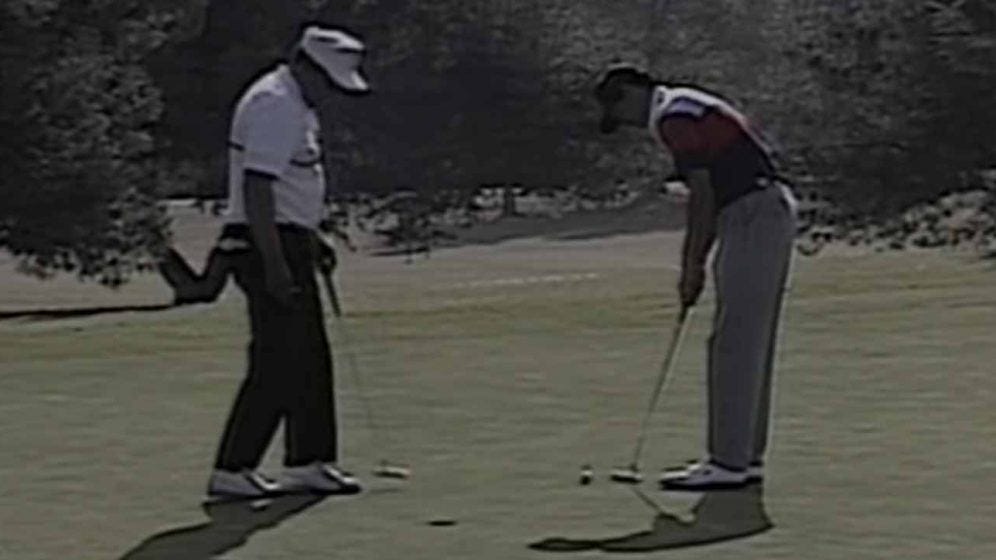By accident or design, was Tiger Woods' ability to freedive one of the pillars of his mental strength on the golf course?
Much has already been made of the techniques employed by Earl Woods to prepare Tiger for the intense mental strength required to succeed under the pressure of competition in elite golf. By creating constant distraction whilst a young Tiger played and practiced, his prodigy eventually learned to cope. He was being exposed to stress, and learned how to deal with it. Likewise, it is also known that Tiger practiced meditation in the form of Buddhism and Tai Chi from a young age. His ability to control his emotions on the golf course has been there for all to see throughout his incredible career, and is arguably the cornerstone of his success.
However there is another element of Tiger’s mental ability, linked to a hobby of his, that to my knowledge - until now - has never been correlated with his performance on course. Freediving. It is widely reported [1] that Tiger can freedive to 100ft (30.5m), and hold his breath underwater (static apnea) for ~4 minutes. For context, Austrian Herbert Nitsch holds the world record for the deepest ‘no limits’ dive of 831ft (253.2m), whilst Branko Petrovic holds the static apnea world record of 11:54. Still, Tiger’s achievements under water are no mean feat.
Freedivers are undoubtedly up there with the mentally strongest athletes around. Why? because the consequence of something going wrong isn’t a missed fairway that leads to a bogey. James Nestor sums it up perfectly in his book, ‘Deep’ [2], “You turn your back on the surface, swim away from your only source of air, and seek out the cold, pain and danger of deep waters. Sometimes you pass out. Sometimes you bleed out of your nose and mouth. Sometimes you don’t make it back alive. Other than BASE jumping, freediving is the most dangerous adventure sport in the world.”
By now you are probably wondering how this relates to golf?
A human's ability to hold their breath, especially in the first stages of apnea, is rather counterintuitive. Our limiting factor isn't about oxygen, our trigger to breathe is dictated by our sensitivity to carbon dioxide (due to its effect on the pH of our blood, which is what we are really sensitive to). We have chemosensors within our body that will send signals to the brain when the level of CO2 (e.g. higher acidity/lower blood pH) has reached the critical point, it will warn us that we need to breathe. Given Tiger can hold his breath for ~4 minutes would suggest that he has - to a point - desensitised himself to CO2. Carbon Dioxide is lauded as a waste gas, but it is actually critically important within our body and specifically to the efficient workings of our respiratory system.
Most interesting is how our emotions and breathing are so explicitly linked. Our evolved, maladapted, brain does not differentiate between a real threat, a perceived threat, or the pressure of holding the lead into Sunday afternoon of a major championship. To our brains, they are one of the same. The part of the brain that controls our emotions and elicits our fear response, the amygdala (part of the limbic system), is also a chemosensor. Suddenly it all makes sense, our limbic brain is hardwired to protect us and keep us alive, and our primal response to not being able to breathe, be it under water, on land, or at altitude, is panic and distress.
As per Ziemann et al [3] "That CO2 initiates a fear response is particularly intriguing because rising CO2 forewarns suffocation, a terrifying situation that demands sensitive detection and action to ensure survival. Thus, it is interesting that evolution positioned a sensor for hypercarbic acidosis in the amygdala, a structure that stimulates the sympathetic nervous system for fight-or-flight and links to other brain regions involved in the response to threat. Thus, the amygdala both senses a threat, posed by CO2, and initiates a response."
Therefore we avoid. We avoid reaching our trigger point of CO2, our bodies have adapted by “staying in a state of alert, by constantly overbreathing in an effort to keep carbon dioxide as low as possible” [4] so we breathe harder and faster, which causes its own cascade of physiological consequences (e.g. adrenaline, cortisol, increase in heart rate, dominance of the sympathetic branch of our nervous system etc etc) that set the tone for our psychological response .

By Tiger training his sensitivity to carbon dioxide, either by accident or design, he was able to better control his breathing and therefore his emotional response to the pressure of competition. He moved towards the problem, faced it head on, and learned to deal with it. As Wim Hof says [5], “Move towards the cold, or the cold will come to you”.
Matt Collings is an advanced Oxygen Advantage breathing instructor. To test your sensitivity to CO2 use a simple test called ‘BOLT’. After a few minutes of calm breathing, fully exhale and hold your breath. Count in seconds until your first definite desire to breathe. Let me know how you get on via email matt@collingsperformance.com
References
[1] Real Men Don’t Use Scuba Tanks, Men's Journal. https://www.mensjournal.com/travel/real-men-dont-use-scuba-tanks-20140918/
[2] James Nestor (2014), Deep. Profile Books.
[3] Zeimann et al, 2009. The Amygdala Is a Chemosensor that Detects Carbon Dioxide and Acidosis to Elicit Fear Behavior. https://core.ac.uk/download/pdf/82278381.pdf
[4] James Nestor (2020), Breath. Penguin Books.
[5] Don’t Tell Me The Score. BBC Podcast. https://www.bbc.co.uk/programmes/p08v95zg




